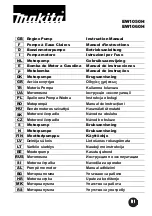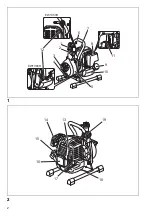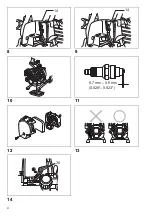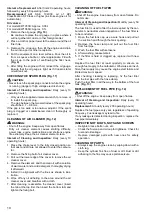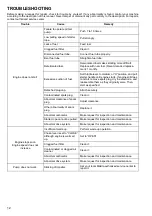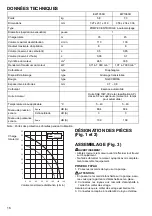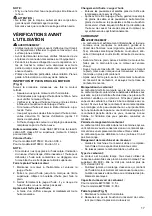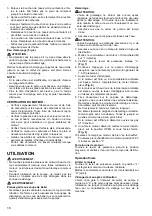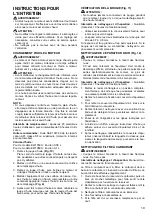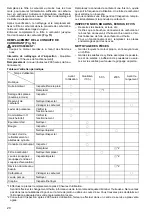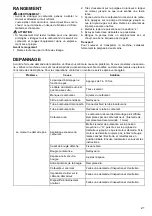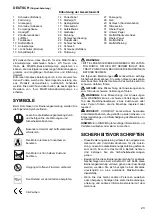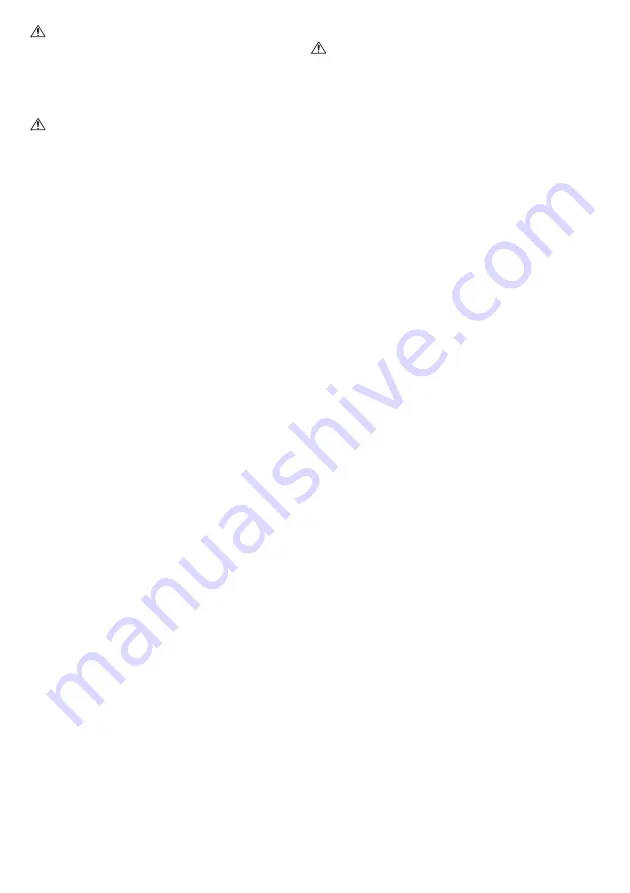
8
CAUTION:
• Do not remove strainer or pump damage may occur by
foreign material.
Check the hose band is securely tightened.
PRE-OPERATION CHECKS
WARNING:
• Before doing any work on the equipment, always stop
the engine. And always carry on work on flat and stable
surface.
• Check the equipment for loose screw or loose connec-
tion parts before starting engine.
• Avoid touching the engine and muffler with any part of
your body or clothing during inspection or repair, while
they are still hot.
• Take special care of ventilation. Beware of CO poison-
ing.
INSPECTION AND REFILL OF ENGINE OIL (Fig. 4)
Perform the following procedure, with the engine cooled
down.
– Assure that the engine is on horizontal position.
– Do not thread the oil gauge into oil filler to check oil
level.
– Check if the oil level is between the lower or upper
limit on the oil gauge.
– If the oil level is below the lower limit, add oil.
– You may need to refill oil approximately every 10
operating hours (every 10 refueling).
– If the oil changes in color or mixes with dirt, replace it
with new one.
Recommended oil:
SAE 10W-30 oil of API Classifica-
tion, Class SF or higher (4-stroke engine for automobile)
Oil volume:
For model EW1050H: Approx. 0.08L
For model EW1060H: Approx. 0.1L
NOTE:
• If the engine is not positioned horizontal, an inaccurate
indication of oil level may occur and oil may be over-
filled. Filling oil above the upper limit may cause oil
contamination or white smoke.
Refilling engine oil
1. Keep the engine in horizontal position, and detach the
oil gauge.
2. Fill with oil to upper limit mark. Use oil bottle when fill-
ing.
3. Securely tighten the oil gauge. Insufficient tightening
may cause oil leakage.
After refilling oil
– Wipe any spilled oil with a rag immediately.
Replacement of oil: Oil gauge
– Remove dust or dirt near the oil refill port.
– Keep the detached oil gauge free from sand or dust.
Otherwise, any sand or dust adhering to the oil cap
may result in problems with irregular oil circulation or
wear on the engine parts.
FUEL
WARNING:
• Fuel is highly flammable and poisonous. Keep away
from open flames (cigarette, stove, fireworks), electric
spark (battery, short circuit, spark from shorted switch,
welding spark etc.) when handling the fuel.
• Be sure to stop the engine before refueling. Do not
refuel when the engine is still hot.
• Other than the occasion of refueling, even when
decanting fuel to small container, always pay ample
attention.
• After refueling, securely tighten the fuel tank cap, and
wipe out spilled fuel completely.
Handling of fuel
It is necessary to handle fuel with utmost care. Fuel may
contain substances similar to solvents. Refueling must
be performed in a sufficiently ventilated room or in the
open air. Never inhale fuel vapor, and keep fuel away
from you. If you touch fuel repeatedly or for a long time,
the skin becomes dry, which may cause skin disease or
allergy. If fuel enters into the eye, clean the eye with fresh
water. If your eye remains still irritated, consult your
doctor.
Storage period of fuel
Fuel should be used within a period of 4 weeks, even if it
is kept in a special container in a well-ventilated and
shaded area.
Otherwise, fuel may deteriorate in one day.
Storage of machine and refill tank
– Keep the machine and tank at a cool place free from
direct sunlight.
– Never keep the fuel in a car.
Type of fuel:
The engine is a four-stroke engine. Be sure to use an
unleaded automobile gasoline 87 or higher octane
((R+M)/2). It may contain no more than 10% alcohol (E-
10).
– Never use a gasoline mixture which contains engine
oil. Otherwise, it will cause excessive carbon
accumulation or mechanical troubles.
Fuel tank capacity:
For model EW1050H: 0.5L
For model EW1060H: 0.65L
Refueling (Fig. 5)
1. Keep the engine in horizontal position.
2. Loosen the fuel tank cap a little to release the tank
pressure.
3. Detach the fuel tank cap, and refuel. DO NOT fill fuel
up to the top of the tank.
4. After refueling, securely tighten the fuel tank cap.
– Wipe the outside of the fuel tank cap to prevent debris
from entering into the fuel tank.
– If there is any flaw or damage on the fuel tank cap,
replace it.
– The fuel tank cap wears out in course of time.
Replace it every two to three years.
– DO NOT put fuel in the oil fill port.

